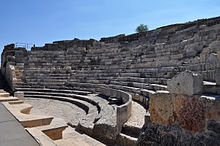
Segóbriga is a former Roman city near Saelices, in the province of Cuenca in Spain. It is possibly one of the most important archaeological sites of the Spanish Meseta.
The name Segóbriga derives from two words: "Sego" meaning victory and "briga" meaning city fortress. The translation would be "City of the Victory" or "Victorious City".
The site includes an amphitheatre, theatre, the city walls and gates, two thermal buildings or Roman baths, and the Forum. There is also a necropolis, and the circus (Roman race track) is being excavated - its outline can be seen from the top of the hill.
Amphitheatre

The amphitheatre was built in front of the theatre with both flanking the gates of the city. The shape is an irregular elliptical form; being 75 metres long it is the biggest monument of Segóbriga with a capacity for 5,500 spectators. Two gates lead into the amphitheatre's arena. A covered corridor links these gates with the rooms where the wild animals were kept.

Theatre
Construction of the theatre began under the emperor Tiberius and was completed during the Flavian dynasty, circa AD 79.

References
- "Discover the Archaeological Park". Archived from the original on 2014-08-14. Retrieved 2014-08-14.
- Information Leaflet from the Segóbriga Archaeological Park
- History of Spanish Architecture
External links
- Volunteer Abroad Projects
- The Interpretation Centre and Opening Times
- Artist's impression recreating the city
This ancient Rome–related article is a stub. You can help Misplaced Pages by expanding it. |